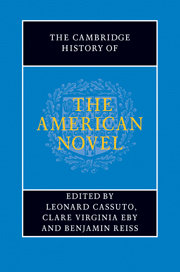Book contents
- Frontmatter
- General Introduction
- PART ONE INVENTING THE AMERICAN NOVEL
- PART TWO REALISM, PROTEST, ACCOMMODATION
- PART THREE MODERNISM AND BEYOND
- Introduction: modernism and beyond
- 37 Stein, Hemingway, and American modernisms
- 38 The Great Gatsby and the 1920s
- 39 Philosophy and the American novel
- 40 Steinbeck and the proletarian novel
- 41 The novel, mass culture, mass media
- 42 Wright, Hurston, and the direction of the African American novel
- 43 Ellison and Baldwin: aesthetics, activism, and the social order
- 44 Religion and the twentieth-century American novel
- 45 Faulkner and the Southern novel
- 46 Law and the American novel
- 47 Twentieth-century publishing and the rise of the paperback
- 48 The novel of crime, mystery, and suspense
- 49 US novels and US wars
- 50 Science fiction
- 51 Female genre fiction in the twentieth century
- 52 Children's novels
- 53 The American novel and the rise of the suburbs
- 54 The Jewish great American novel
- 55 The Beats and the 1960s
- 56 Literary feminisms
- 57 Reimagining genders and sexualities
- PART FOUR CONTEMPORARY FORMATIONS
- A selected bibliography
- Index
48 - The novel of crime, mystery, and suspense
from PART THREE - MODERNISM AND BEYOND
Published online by Cambridge University Press: 28 July 2011
- Frontmatter
- General Introduction
- PART ONE INVENTING THE AMERICAN NOVEL
- PART TWO REALISM, PROTEST, ACCOMMODATION
- PART THREE MODERNISM AND BEYOND
- Introduction: modernism and beyond
- 37 Stein, Hemingway, and American modernisms
- 38 The Great Gatsby and the 1920s
- 39 Philosophy and the American novel
- 40 Steinbeck and the proletarian novel
- 41 The novel, mass culture, mass media
- 42 Wright, Hurston, and the direction of the African American novel
- 43 Ellison and Baldwin: aesthetics, activism, and the social order
- 44 Religion and the twentieth-century American novel
- 45 Faulkner and the Southern novel
- 46 Law and the American novel
- 47 Twentieth-century publishing and the rise of the paperback
- 48 The novel of crime, mystery, and suspense
- 49 US novels and US wars
- 50 Science fiction
- 51 Female genre fiction in the twentieth century
- 52 Children's novels
- 53 The American novel and the rise of the suburbs
- 54 The Jewish great American novel
- 55 The Beats and the 1960s
- 56 Literary feminisms
- 57 Reimagining genders and sexualities
- PART FOUR CONTEMPORARY FORMATIONS
- A selected bibliography
- Index
Summary
About a third of the way through Tender is the Night (1934), as Dick Diver is about to begin the precipitous decline that is the subject of Fitzgerald's novel, the young psychiatrist encounters a displaced American veteran in a neighborhood on the outskirts of Paris. The man reminds Dick of
a type of which he had been conscious since early youth … [i]ntimate to garages, where he had vague business conducted in undertones, to barber shops, to the lobbies of theaters … Sometimes the face bobbed up in one of Tad's more savage cartoons – in boyhood Dick had often thrown an uneasy glance at the dim borderland of crime on which he stood.
This scene plays a minor yet structurally significant role in Fitzgerald's novel. The unnamed veteran – who provides a “menacing,” working-class counterpoint to Dick's romantic memories of the war and to his visions of personal and national destiny – will return in the novel's final pages as a reminder of Dick's fateful collapse. But he is also more broadly representative of some of the salient qualities of American literary modernism, which is full of similarly menacing marginal figures. Meyer Wolfshiem in The Great Gatsby (1925), Sam Cardinella in Hemingway's In Our Time (1925), Faulkner's Popeye (in Sanctuary [1929]) or Joe Christmas (in Light in August [1932]) – all are, like the nameless veteran of Tender is the Night, examples of the ambivalent fascination with which the modernists regarded the development of a transient urban working class.
- Type
- Chapter
- Information
- The Cambridge History of the American Novel , pp. 798 - 812Publisher: Cambridge University PressPrint publication year: 2011



